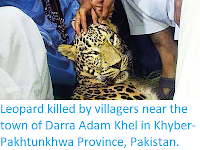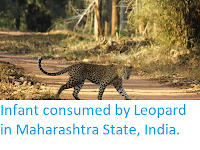Large carnivore populations have declined sharply around the world in the past two centuries, principally due to hunting by Humans. This has led to efforts to protect these animals by conservationists and lawmakers, which in turn has resulted in limited population recovery in many areas. Unfortunately rising populations of carnivores have quickly come into conflict with local Human populations, which are also rising and have occupied many areas that were wilderness until very recently. In many parts of the world this has resulted in the hunting of large carnivores seen as a threat to Humans or domestic animals, either legally or illegally, as well as pressure on governments to withdraw the protected status of these animals. In South Asia attacks upon domestic animals by Tigers, Panthera tigris, and leopards Panthera pardus, have become a particular problem, though possibly retaliations by Humans have been more measured than in other regions, due to cultural values and beliefs which promote wildlife conservation.
In a paper published in the journal Orynx on 2 July 2019, Subodh Upadhyaya of the Institute of Environmental Sciences at Leiden University, and the School of Science at Kathmandu University, Kees Musters, also of the Institute of Environmental Sciences at Leiden University, Babu Ram Lamichhane of the Biodiversity Conservation Center of the National Trust for Nature Conservation, the Institute of Cultural Anthropology and Development Sociology at Leiden University and the Evolutionary Ecology Group at Antwerp University, Geert de Snoo, again of the Institute of Environmental Sciences at Leiden University, Maheshwar Dhakal of the Biodiversity and Environment Division of the Ministry of Forest and Soil Conservation of Nepal, and Hans de Iongh, once again of the Institute of Environmental Sciences at Leiden University, and the Evolutionary Ecology Group at Antwerp University, describe the results of a study into wildlife attacks around the Bardia National Park in Nepal, and the impact that this had upon villagers views of the project.
The Bardia National Park was established in 1976 and covers 968 km² of land in south-western Nepal, forming the largest national park in the plains habitat. A 327 km² buffer zone was established around the park in 1996, in which agriculture is permitted, albeit where restrictions are placed upon resource use, and special development measures are undertaken to enhance the conservation values of the area, with an additional 180 km²of primarily hilly terrain in the Surkhet district added in 2010.
Upadhyaya et al. used a structured questionnaire to assess the attitudes of 297 households in four sectors around the park to wildlife and conservation. Two of these sectors (Thakurdwara and Western) were characterised by relatively high densities of both natural prey and livestock, while the other two (Eastern and Northern) had relatively low densities of natural prey but high livestock densities. The survey was designed to assess the attitudes of (1) wildlife in general, (2) wildlife conservation in general, (3) wildlife conservation when family members were affected by wildlife, and (4) wildlife conservation amongst respondents personally affected by livestock losses to predators.
92 of the households surveyed reported having lost livestock to wildlife attacks, with 78 of these attacks carried out by Leopards, eight by Tigers and six by other animals. Most of the Leopard attacks were on Goats, with Pigs, Sheep, and Cattle also attacked. All bar one of the Tiger attacks were on Cattle, with the final attack being on an Buffalo. 46% of the attacks happened during the summer, 35% in the winter and 19% in the monsoon season. 81% occurred within villages, with only 19% outside.
The total cost to the surveyed villagers of livestock attacks was estimated to be US$14 573, based upon values per animal of between US$30 and US$50. 93% of the respondents reported positive attitudes towards wildlife and conservation, even where they had relatives who had lost livestock to animal attacks, this overall positivity fell slightly among villagers that had lost livestock personally, with only 80% reporting positive attitudes towards wildlife and conservation. Respondents from the Western sector were most supportive of conservation, followed by Thakurdwara, Eastern, and Northern sectors, in this order. Respondents with a higher level of education were more positive towards wildlife in general, and willing to conserve wildlife. Respondents who were self-sufficient (i.e. generating crop yields that could sustain their household throughout the year) were more positive about wildlife conservation in general than respondents who were not self sufficient. Men were more positive about wildlife conservation than women.
Contrary to our expectations, respondents who had lost livestock to tigers had a positive attitude towards wildlife conservation. Upadhyaya et al. suggest that the fact that Tigers were regarded more favourably is a reflection of the cultural values prevalent in this region; people from Bardia believe that tigers are the vehicle of Durga, the goddess of might, and should not be harmed, whereas Leopards do not benefit from tolerance based on religious beliefs.
The attitude of villagers who had lost livestock towards conservation varied considerably from sector to sector, with 98% of respondents in the Thakurdwara and Western sectors reporting positive attitudes, while 80% in the eastern and only 50% in the northern sector were positive towards wildlife conservation. Households in the northern sector suffered considerably higher economic damage compared to other sectors, which can be attributed to poor husbandry techniques, such as open sheds. The difference in attitudes between respondents from the Western sector and those from the Northern sector is probably a consequence of the difference in numbers of livestock lost between these two sectors. In addition, interviewees from the northern sector were generally dissatisfied because this area was incorporated into the Park’s buffer zone more recently (in 2010) and residents have not benefited from the buffer zone programme to the same extent as people in other sectors, where 30-50% of Park revenue has been allocated to community development activities.
Villagers with a lower socio-economic status lost significantly more livestock compared to villagers who could afford better protection measures and husbandry techniques such as predator-proof corrals. People from marginalised groups are severely affected by such financial losses. Although people’s attitudes towards wildlife can be influenced by predator attacks and other wildlife-related financial losses, in general people are more tolerant of wildlife if they derive benefits from a protected area. Therefore, active involvement of local communities in planning, executing and managing small scale conservation projects leads to a positive attitude towards conservation.
See also...
Bardia National Park and its buffer zone, showing the study sectors, surveyed households and cases of reported livestock loss. Upadhyaya et al. (2019).
Upadhyaya et al. used a structured questionnaire to assess the attitudes of 297 households in four sectors around the park to wildlife and conservation. Two of these sectors (Thakurdwara and Western) were characterised by relatively high densities of both natural prey and livestock, while the other two (Eastern and Northern) had relatively low densities of natural prey but high livestock densities. The survey was designed to assess the attitudes of (1) wildlife in general, (2) wildlife conservation in general, (3) wildlife conservation when family members were affected by wildlife, and (4) wildlife conservation amongst respondents personally affected by livestock losses to predators.
A Tiger in the Bardia National Park of southwest Nepal.
92 of the households surveyed reported having lost livestock to wildlife attacks, with 78 of these attacks carried out by Leopards, eight by Tigers and six by other animals. Most of the Leopard attacks were on Goats, with Pigs, Sheep, and Cattle also attacked. All bar one of the Tiger attacks were on Cattle, with the final attack being on an Buffalo. 46% of the attacks happened during the summer, 35% in the winter and 19% in the monsoon season. 81% occurred within villages, with only 19% outside.
A village in the buffer zone of the Bardia National Park. Eyes on Nepal.
The total cost to the surveyed villagers of livestock attacks was estimated to be US$14 573, based upon values per animal of between US$30 and US$50. 93% of the respondents reported positive attitudes towards wildlife and conservation, even where they had relatives who had lost livestock to animal attacks, this overall positivity fell slightly among villagers that had lost livestock personally, with only 80% reporting positive attitudes towards wildlife and conservation. Respondents from the Western sector were most supportive of conservation, followed by Thakurdwara, Eastern, and Northern sectors, in this order. Respondents with a higher level of education were more positive towards wildlife in general, and willing to conserve wildlife. Respondents who were self-sufficient (i.e. generating crop yields that could sustain their household throughout the year) were more positive about wildlife conservation in general than respondents who were not self sufficient. Men were more positive about wildlife conservation than women.
A Leopard in the Bardia National Park. LamaKarma.
Contrary to our expectations, respondents who had lost livestock to tigers had a positive attitude towards wildlife conservation. Upadhyaya et al. suggest that the fact that Tigers were regarded more favourably is a reflection of the cultural values prevalent in this region; people from Bardia believe that tigers are the vehicle of Durga, the goddess of might, and should not be harmed, whereas Leopards do not benefit from tolerance based on religious beliefs.
A Tiger in the Bardia National Park. Nepal Adventure Point.
The attitude of villagers who had lost livestock towards conservation varied considerably from sector to sector, with 98% of respondents in the Thakurdwara and Western sectors reporting positive attitudes, while 80% in the eastern and only 50% in the northern sector were positive towards wildlife conservation. Households in the northern sector suffered considerably higher economic damage compared to other sectors, which can be attributed to poor husbandry techniques, such as open sheds. The difference in attitudes between respondents from the Western sector and those from the Northern sector is probably a consequence of the difference in numbers of livestock lost between these two sectors. In addition, interviewees from the northern sector were generally dissatisfied because this area was incorporated into the Park’s buffer zone more recently (in 2010) and residents have not benefited from the buffer zone programme to the same extent as people in other sectors, where 30-50% of Park revenue has been allocated to community development activities.
A village in the Bardia National Park. Workaway.
Villagers with a lower socio-economic status lost significantly more livestock compared to villagers who could afford better protection measures and husbandry techniques such as predator-proof corrals. People from marginalised groups are severely affected by such financial losses. Although people’s attitudes towards wildlife can be influenced by predator attacks and other wildlife-related financial losses, in general people are more tolerant of wildlife if they derive benefits from a protected area. Therefore, active involvement of local communities in planning, executing and managing small scale conservation projects leads to a positive attitude towards conservation.
See also...
Follow Sciency Thoughts on
Facebook.












